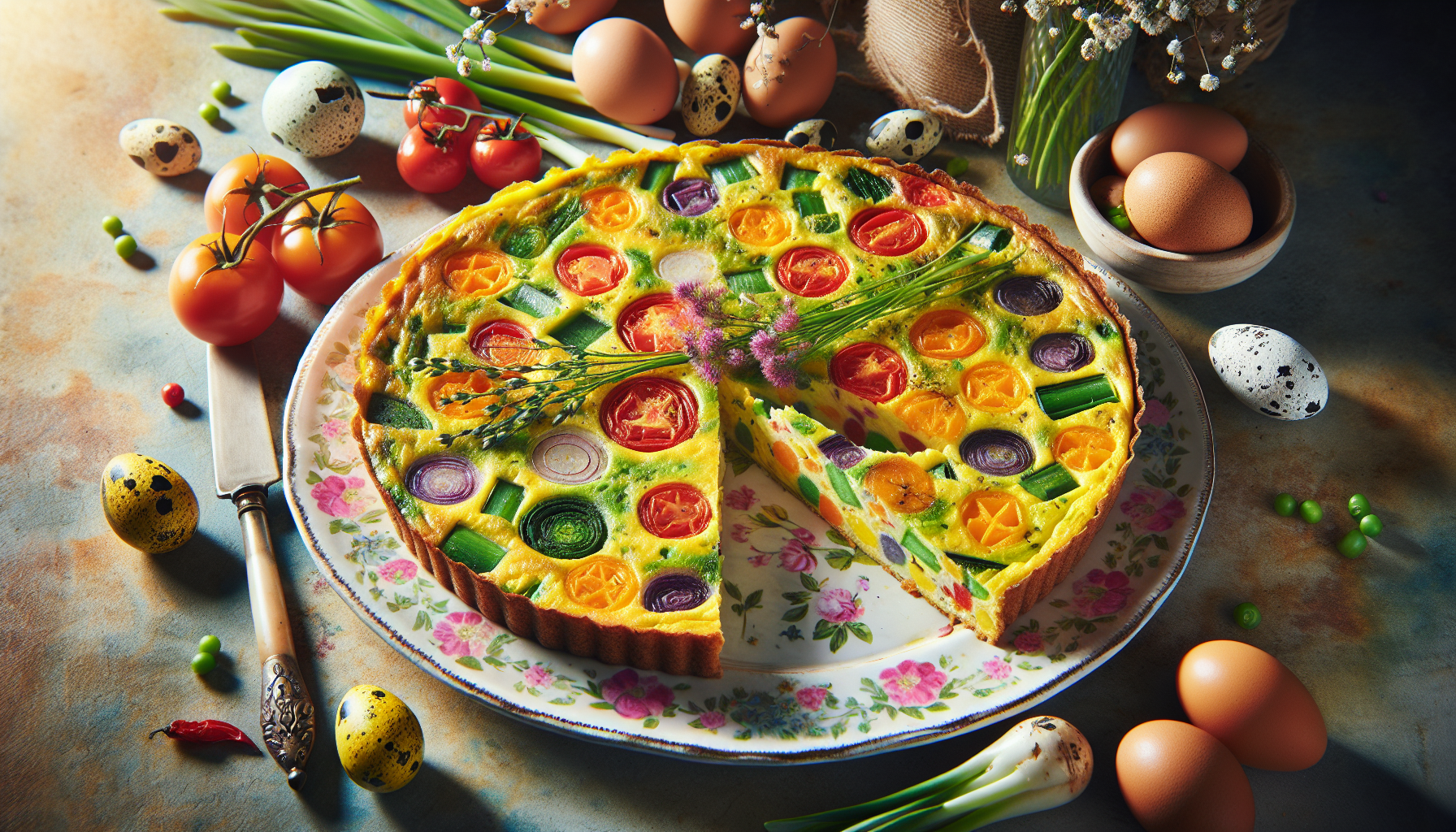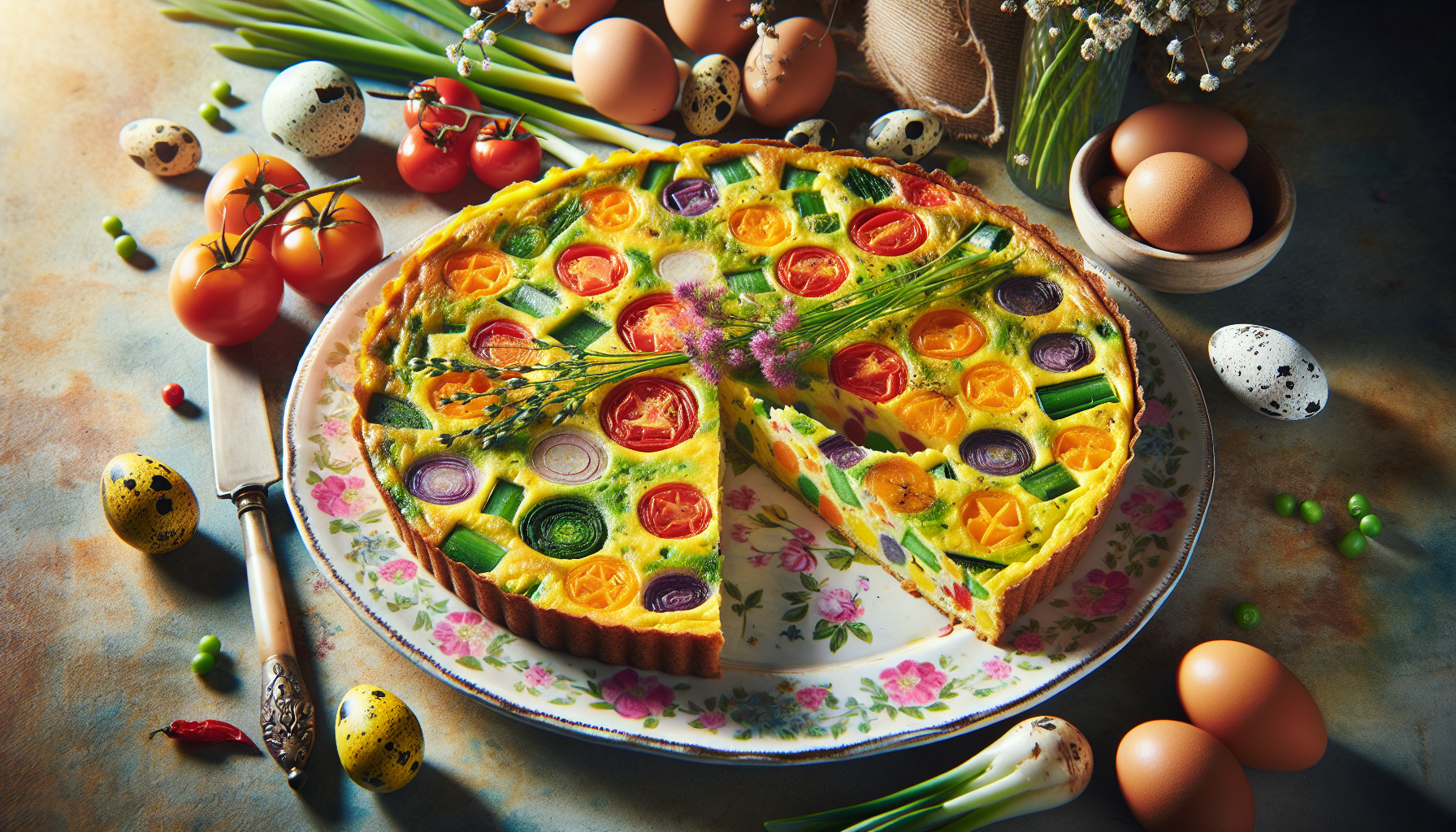Get ready to impress your family and friends this Easter with a delicious and colorful One-Pan Spring Vegetable Frittata. Packed with fresh seasonal veggies and bursting with flavors, this recipe is perfect for a hearty brunch or a light dinner. With easy-to-follow steps and precise measurements, you’ll be able to whip up this delightful dish in no time. So gather your ingredients and let’s get cooking!
Ingredients
Eggs
Eggs are the main component of a frittata, providing a creamy and velvety texture. For a standard-sized frittata, you will typically need 6 to 8 large eggs.
Spring vegetables
Spring vegetables add freshness and crunch to the frittata, making it the perfect dish to celebrate the arrival of the season. Common spring vegetables used in a frittata include asparagus, peas, baby spinach, and spring onions. Feel free to mix and match according to your preference.
Cheese
Cheese adds a delightful gooeyness and enhances the flavors of the frittata. Opt for a cheese that melts well, such as shredded cheddar, feta, or goat cheese. You will need around 1 cup of cheese, but you can adjust the amount to suit your taste.
Herbs and spices
Herbs and spices bring depth and complexity to the frittata. Popular choices include chopped fresh herbs like parsley, basil, and chives, as well as dried herbs such as thyme or oregano. Use about 1 tablespoon of mixed herbs and spices for a flavorful frittata.
Salt and pepper
To season the frittata, you will need salt and pepper to taste. These pantry staples help to enhance the flavors of the other ingredients and bring balance to the overall dish.
Preparation
Preheat the oven
Before you start preparing the frittata, preheat your oven to 375°F (190°C). This ensures that the oven is sufficiently hot when it’s time to bake the frittata, resulting in a perfectly cooked dish.
Prepare the vegetables
Wash and chop the spring vegetables of your choice. For asparagus, trim the tough ends and cut them into bite-sized pieces. If using peas, you can thaw frozen peas or blanch fresh peas before adding them to the frittata. For the spinach, remove any tough stems and roughly chop the leaves. Spring onions can be sliced thinly, including the green parts.
Beat the eggs
In a large bowl, crack the eggs and whisk them until fully combined. Whisking the eggs thoroughly ensures that the frittata has a consistent texture and that the eggs are evenly distributed.
Cook the vegetables
Heat a tablespoon of olive oil in an oven-safe skillet over medium heat. Add the prepared vegetables and sauté until they are just tender, usually about 5 minutes. Season the vegetables with salt, pepper, and your preferred herbs and spices. Stir well to evenly coat the vegetables with the seasoning.
Add the eggs and cheese
Once the vegetables have cooked, pour the beaten eggs over them in the skillet. Gently stir to combine the eggs and vegetables, ensuring that they are evenly distributed. Sprinkle the cheese on top of the mixture, allowing it to melt and blend with the eggs as it bakes.
Bake the frittata
Transfer the skillet to the preheated oven and bake for approximately 20 minutes or until the frittata is set and slightly golden on top. To check if the frittata is cooked, insert a knife into the center – it should come out clean. Once cooked, remove the skillet from the oven and let the frittata cool for a few minutes before serving.

Serving
Garnish
To elevate the presentation of your frittata, consider adding a garnish. Fresh herbs, such as chopped parsley or chives, can be sprinkled on top. A squeeze of lemon juice over the frittata can add a tangy and refreshing touch. Get creative and experiment with different garnishes to suit your taste!
Accompaniments
A frittata can be enjoyed on its own as a satisfying and flavorsome meal. However, if you wish to serve it alongside other dishes, there are several accompaniments that pair well with a spring vegetable frittata. Some options include a side salad dressed with a light vinaigrette, crusty bread or rolls, or a refreshing fruit salad.
Variations
Adding protein
If you want to boost the protein content of your frittata, you can add cooked bacon, diced ham, or cooked chicken. Simply cook the meat separately and add it to the frittata mixture before baking. This addition adds an extra layer of flavor and makes the frittata more substantial.
Using different vegetables
While spring vegetables are the traditional choice for a spring vegetable frittata, you can easily adapt the recipe to your liking. Experiment with different vegetables based on what’s in season or what you have on hand. Bell peppers, zucchini, mushrooms, or cherry tomatoes can all be delicious additions to your frittata.
Making it dairy-free
If you’re lactose intolerant or prefer a dairy-free frittata, you can omit the cheese or replace it with dairy-free alternatives. There are many plant-based cheeses available that melt well and add a similar creaminess to your frittata.

Tips and Tricks
Choosing the right pan
To ensure your frittata cooks evenly, it’s important to use an oven-safe skillet or frying pan. A non-stick skillet or a well-seasoned cast-iron pan works best. Make sure the pan is large enough to accommodate the frittata mixture without overflowing.
Cooking time
The cooking time may vary depending on your oven and the thickness of the frittata. Keep an eye on the frittata as it bakes and check for doneness by inserting a knife into the center. If the knife comes out clean, the frittata is ready. Remember that it will continue to cook slightly as it cools.
Storage
If you have leftovers, the frittata can be stored in an airtight container in the refrigerator for up to 3 days. To reheat, gently warm slices of the frittata in a skillet over low heat until heated through. This way, you can enjoy the frittata as a quick and convenient meal throughout the week.
Health Benefits
Nutritional value
A spring vegetable frittata is not only delicious but also packed with nutrients. Eggs provide high-quality protein and are rich in vitamins and minerals, including vitamin B12 and selenium. Spring vegetables are low in calories and high in fiber, vitamins, and antioxidants. This combination makes for a nutritious dish that can support a balanced diet.
Recommended serving size
The recommended serving size for a frittata is typically one or two slices, depending on the size of the slices and your appetite. Pair it with a side of mixed greens or other vegetables to create a well-rounded and satisfying meal. Remember to listen to your body’s hunger and fullness cues to determine your ideal serving size.
Conclusion
A one-pan spring vegetable frittata is a versatile and delicious dish that celebrates the flavors of the season. With its creamy texture, burst of colors, and a myriad of possible variations, it’s no wonder the frittata has become a staple in brunch menus and dinner tables. By following these simple steps and experimenting with different ingredients, you can create a frittata that suits your taste and showcases the freshness of spring vegetables. So give it a try and savor this delightful dish that brings the essence of spring to your plate. Enjoy!
